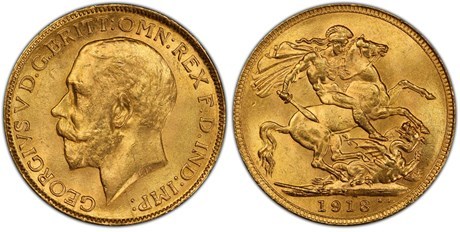1918-I Certificate of Indian Gold Sovereignty
Release time:2023-05-22

1918-I was designed by Sir Edgar Bertram MacKennal, and the mold was supplied to India by the Royal Mint in London. Its obverse is George V's bald head, facing to the left, "B.M." (Bombay Mint) relief. (Bombay Mint) relief at the truncation. On the reverse is the famous St. George and the Dragon, facing right, designed in 1821 by Benedetto Pistrucci, a design that has become synonymous with golden sovereignty. Under the broken spear lying on the ground there is a relief "WWP". The B.P. (relief) under the ground line is dated "1918". On the ground line is the letter I (for India). Courtesy of PCGS.
From the first gold coin
issued under Henry VII in 1489, to its replacement by Gini in the 17th and 18th centuries, to its reintroduction again in 1817, the sovereign coin has been an important part of British gold coins for 500 years, attracting the attention of British monarchs.
Before the First World War, from 1914 to 1918, sovereign coins were very liquid and it was often seen trading. After that, such coins cease to be active members in circulation. Many countries, including the United Kingdom, faced huge fiscal imbalances, could no longer afford coins minted in gold and intermittently suspended the exchange of gold. A few years after the war, in 1925, Britain reverted to the gold standard. However, that was short-lived, as the Great Depression of 1931 ended convertibility permanently. But gold sovereignty remained a coin that helped stabilize the international exchange rate regime. Interestingly, the British gold sovereignty of 1925 was minted until 1952! In recent decades, sovereign gold coins and other gold coins have been minted mainly for commemorative purposes.
1918-I Gold sovereignty and its relationship with India
Historically, it was common practice in the Royal Mint to bring gold from its territory to mint coins and then ship them back for redistribution. Given the widespread circulation of these sovereign coins, there is also a growing desire to mint them locally. In the 19th century, the Royal Mint began using branches to mint sovereign coins as close to the gold source as possible. This began with the opening of various branches of the Royal Mint in Sydney (1855), Melbourne (1872), Perth (1899), Haussmann (1908) and Bombay (1917).
The
intention to establish a branch of the Royal Mint in Bombay was consolidated during World War I, when the German Navy began targeting ships carrying gold from South Africa to London. To avoid this, gold was secretly shipped to India and made into sovereign currency. When the war ended in November 1918, gold could again be safely shipped from South Africa to London, and production was no longer required in India, where the minting of coins was stopped. These Indian sovereign coins are therefore known as World War I emergency sovereign coins.
The Bombay branch of the
Royal Mint (established under the Bombay Mint Proclamation of 21 December 1917) was separated from the Bombay Mint under the Government of India, and molds and tools were not shipped from London until June 1918. In August of the same year, the original Bombay Mint supplied the coin press and blank, and production began on August 15, 1918. However, due to the end of the war in November, the Royal Mint's branch in Mumbai produced only one issue of sovereignty. The mint closed in April 1919 and the molds were shipped back to the Royal Mint, which explains why we did not see a reprint of the 1918-I sovereignty.
At the PCGS Set Registry, 1918 Sovereignty from India can be collected in various sets, including Indian Sovereignty, Circulation Batting (1918, 2013 to the present) set. This is certainly a scarcity, with only 1,296,033 coins minted – a fairly small period compared to the 12 million coins produced in Australia in the same year. Gold sovereignty or "ginni", as it is mentioned in much of India, remains a popular gold and silver item, and it can often be seen adorned with brooches and even as pendants for necklaces.
keyword:1918-I Certificate of Indian Gold Sovereignty
previous



